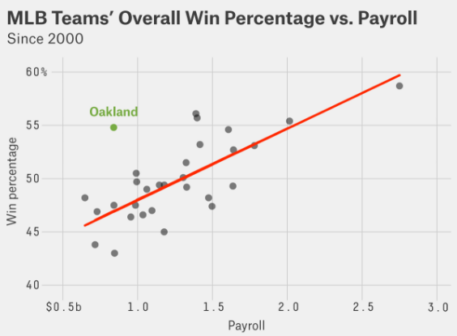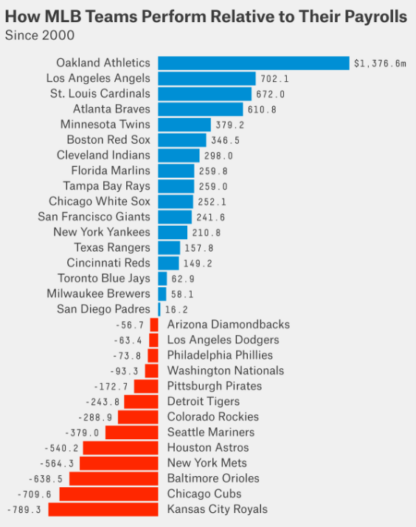In a world driven by data, the value of a proficient analytics team cannot be overstated. This article explores the significance of a well-structured analytics team, drawing inspiration from the billion-dollar insights of “Billion Dollar” Billy Beane, the unconventional data sources that fuel Major League Baseball (MLB) teams, and the strategic implications of sabermetrics in Japanese baseball. We’ll uncover how the collective wisdom of analytics teams transcends industries and why it’s akin to holding a billion-dollar treasure.
Why Should You Care? The value of analytics isn’t limited to sports; it’s a game-changer in industries spanning from finance and healthcare to marketing and retail. A top-notch analytics team can drive innovation and optimize decision-making processes, resulting in tangible financial gains.
Who Should Care? Analytics is the backbone of informed decision-making across industries, making this article relevant to professionals, leaders, and enthusiasts eager to harness the power of data.
What We’ll Cover
In this article, we’ll explore the following key aspects:
- Billy Beane’s Billion-Dollar Insights: We’ll dive into the story of Billy Beane, the mastermind behind the Oakland Athletics’ transformative journey in Major League Baseball as they used data analytics and how that strategic move converted into over 1 billion dollars.
- Surprising Data Sources in MLB: We’ll unveil the unexpected places from which MLB teams gather their data, highlighting the breadth and depth of data-driven decision-making in sports.
- Sabermetrics in Japanese Baseball and its Business Analytics Parallels: We’ll examine how sabermetrics, the advanced statistics of baseball, has found its way into Japanese baseball and how its principles resonate with business analytics.

Billy Beane in the Oakland Alameda County Coliseum in Oakland California
The Value of a Proficient Analytics Team: Billy Beane’s Data-Driven Success
In the world of sports, Billy Beane’s name is synonymous with data-driven success. His story is a testament to the transformative power of data in the world of sports, particularly in Major League Baseball (MLB). Beane’s journey from a former player to the innovative general manager of the Oakland Athletics is a compelling narrative of how data-driven decision-making can revolutionize an entire industry.
Challenging the Status Quo
In the early 2000s, the Oakland Athletics faced a daunting challenge. With one of the lowest payrolls in MLB, they were struggling to compete against teams with significantly larger budgets. This financial disparity seemed insurmountable, but Beane refused to accept defeat. Instead, he turned to data and analytics to level the playing field.
The Birth of “Moneyball”
Beane’s approach, later immortalized in Michael Lewis’s book “Moneyball” and the subsequent film adaptation was rooted in the principles of sabermetrics—a sophisticated form of baseball analytics. Rather than relying on traditional scouting and subjective judgments, Beane and his team embraced objective data to evaluate player performance.
Key Elements of Beane’s Data-Driven Strategy
- Identifying Undervalued Metrics: Beane’s team identified key performance metrics that were undervalued by the rest of the league, such as on-base percentage (OBP) and slugging percentage (SLG). By focusing on these metrics, they could identify players who were statistically undervalued.
- Market Inefficiencies: Beane exploited market inefficiencies by targeting players who were overlooked by other teams due to biases or conventional scouting methods. This allowed the Athletics to acquire talent at a lower cost.
- Resource Allocation: With limited financial resources, Beane strategically allocated the team’s budget to acquire players who offered the greatest statistical value. This approach maximized the team’s competitiveness within their budget constraints.
The Impact on the Athletics
Under Beane’s leadership, the Oakland Athletics achieved remarkable success. Despite their financial limitations, they consistently competed at a high level, making the playoffs in multiple seasons. This success challenged the traditional wisdom of baseball and inspired other teams to adopt data-driven approaches.

Lessons for Business Analytics
Beane’s approach to baseball analytics holds valuable lessons for the world of business analytics:
- Data-Driven Decision-Making: Just as Beane used data to make informed player personnel decisions, organizations can use data to drive smarter business decisions, from marketing strategies to supply chain optimization.
- Identifying Key Metrics: Beane’s focus on undervalued metrics underscores the importance of identifying the right key performance indicators (KPIs) in business. Understanding which metrics matter most can lead to more effective strategies.
- Resource Optimization: Beane’s resource allocation strategy demonstrates the value of optimizing resources to maximize outcomes. In business, this translates to efficient budget allocation and resource management.
Value of their data team
The value of Billy Beane’s data team is nothing short of a billion dollars, a testament to their extraordinary ability to transform a struggling baseball franchise into a competitive powerhouse. By the time Beane and his data team retired from the Oakland Athletics after 15 years, the Athletics’ had exceeded profitability expectations by nearly $1.38 billion, demonstrating the value of analytics when applied carefully and thoughtfully.
Through data-driven insights and innovative analytics, Beane’s team revolutionized player evaluation and game strategy, achieving remarkable success on a limited budget. This billion-dollar impact demonstrates the profound value that a proficient analytics team can bring to an organization, transcending the realm of sports and echoing across industries where data-driven decisions hold the key to prosperity and innovation.

2014 Landscape
In 2014, most of the Major League Baseball (MLB) teams were trading at valuations below the coveted billion-dollar mark. This intriguing fact underscores the potential for organizations to invest in cutting-edge analytics and data infrastructure, similar to what Billy Beane and his team did with the Oakland Athletics. With the ability to acquire an MLB club for less than $1.2 billion, teams had the financial leeway to invest in the best equipment and data resources, enabling them to harness the transformative power of data-driven decision-making in the pursuit of success on the field and beyond.
Considering the exceeded profitability expectations of 2014, it would have been possible to purchase almost any MLB club for less than that amount. With excess funds, teams could pay for the best equipment and data so that Beane and his team could work their magic to achieve success and profit as a team owner.
Unconventional Data Sources in MLB
MLB teams are increasingly turning to unconventional sources for data. In a world where every pitch, swing, and statistic counts, data is the lifeblood of decision-making. While traditional baseball statistics have been essential for decades, the digital age has ushered in a new era of data collection, where unconventional sources play a pivotal role in gaining a competitive edge. This section explores these non-traditional data sources in MLB and how their relevance extends far beyond the baseball diamond into the realm of business analytics.
Non-traditional Data in MLB
- Player Tracking Technology: MLB teams now employ advanced player tracking systems such as Kinatrax that record every movement on the field. These systems use high-speed cameras and radar technology to capture data points like pitch velocity, spin rate, launch angle, and fielder positioning. This granular player tracking data provides insights into player performance and strategy.
- Wearable Technology: Players wear sensors and devices that track their movements and vital statistics during games and practices such as Motus and their sleeve motusTHROW. This data includes heart rate, fatigue levels, and biomechanical measurements. It aids in injury prevention, player development, and performance optimization.
- Social Media Sentiment Analysis: MLB teams and marketing departments scour social media platforms to gauge fan sentiment and engagement. This analysis helps tailor marketing campaigns, improve fan experiences, and identify trends.
- Fan Attendance Data: Data on ticket sales, attendance patterns, and concessions purchases inform stadium operations and marketing efforts. It aids in pricing strategies, event planning, and fan engagement initiatives.
- Weather Data: Weather conditions can significantly impact game outcomes and attendance. Teams use real-time weather data to make game-time decisions, such as postponements or adjustments to game strategy.
The Relevance to Business Analytics
The use of unconventional data sources in MLB has several parallels to business analytics:
- Data Integration: Just as MLB teams integrate data from diverse sources, businesses benefit from integrating data from various departments and external sources. This holistic view informs strategic decisions.
- Predictive Analytics: Player tracking data in MLB allows teams to predict player performance and game outcomes. In business, predictive analytics can forecast market trends, customer behaviour, and financial performance.
- Customer Sentiment Analysis: Similar to social media sentiment analysis in sports, businesses use sentiment analysis to understand customer opinions and feedback. This informs marketing strategies, product development, and customer service improvements.
Sabermetrics in Japanese Baseball
Beyond North America, the sabermetrics revolution has begun to reach Japanese baseball. Teams in Nippon Professional Baseball (NPB) have taken steps to embrace data analytics to enhance player performance and team strategy, proving that the principles of sabermetrics transcend borders and industries.

Takuya Nakashima At-Bat
The integration of sabermetrics, the advanced statistical analysis of baseball, into Japanese baseball, is a fascinating journey that offers insights not only into the world of sports but also into the realm of business analytics. This section delves into the strategic implications of sabermetrics in Japanese baseball and its profound ties to the principles of business analytics.
Sabermetrics: A Global Phenomenon
Originating in the United States under SABR (Society of American Baseball Research) and initially known as sabermetrics, it is the quantitative study of in-game baseball metrics. Sabermetrics gained worldwide recognition following the success of “Moneyball” in MLB. Japanese baseball, known for its rich tradition and unique playing style, also began to take steps to integrate sabermetrics as a tool for player evaluation and strategic decision-making.
Key Aspects of Sabermetrics in Japanese Baseball
- Player Evaluation: Japanese teams use advanced metrics and tools such as the TrackMan to evaluate player performance beyond traditional statistics. Metrics like batted ball exit speed, slugging percentage (SLG), and fielding independent pitching (FIP) offer a more comprehensive view of a player’s contribution.
- Game Strategy: Sabermetrics guides in-game strategy, such as defensive shifts based on batter tendencies and optimal pitching matchups. Teams make data-driven decisions on when to pull pitchers or pinch-hit based on historical success rates.
- Player Development: Data-driven player development programs focus on improving specific skills. Pitchers, for instance, may receive feedback on optimizing pitch selection based on batter weaknesses.
Business Analytics Parallels
The influence of sabermetrics in Japanese baseball resonates strongly with the principles of business analytics:
- Data-Driven Decision-Making: Just as sabermetrics informs in-game decisions, businesses employ data to drive real-time decisions in areas like marketing, inventory management, and pricing strategies.
- Performance Evaluation: Sabermetrics evaluates player performance holistically, beyond superficial statistics. Similarly, businesses use advanced analytics to assess employee performance, customer behaviour, and product success.
- Customer Insights: In baseball, sabermetrics uncovers insights about player tendencies. In business, customer analytics uncovers patterns, preferences, and purchasing behaviour, allowing for targeted marketing and product development.
- Risk Management: Sabermetrics evaluates risks and uncertainties in-game scenarios. Businesses analyze risks in supply chains, investments, and operations to make informed decisions.
- Resource Optimization: Sabermetrics guides resource allocation in player salaries and team investments. Business analytics informs budget allocation, resource management, and cost optimization.
Worth a Billion Dollars
In conclusion, the value of a proficient analytics team, armed with the insights that span industries, is nothing short of a billion dollars. Billy Beane’s billion-dollar success story, unconventional data sources in MLB, and the impact of sabermetrics in Japanese baseball all underscore the transformative power of data analytics.
Key Takeaways of Business Analytics
- Data-Driven Decision-Making: Harnessing data for decisions is pivotal for success in sports, business, and beyond.
- Resource Allocation: Effective resource allocation, based on data insights, is key to achieving optimal outcomes.
- Customer Insights: Understanding customer behaviour through data analytics informs targeted strategies and product development.
- Risk Mitigation: Data analysis helps identify and mitigate risks, ensuring a more secure and informed path forward.
Ready to unlock the billion-dollar potential of analytics for your organization? Contact our expert team to discover how we can help you leverage data-driven insights and elevate your business to new heights. Explore our other insightful content to delve deeper into the world of analytics and data-driven decision-making. The future is data-driven; it’s time to claim your billion-dollar insight.
